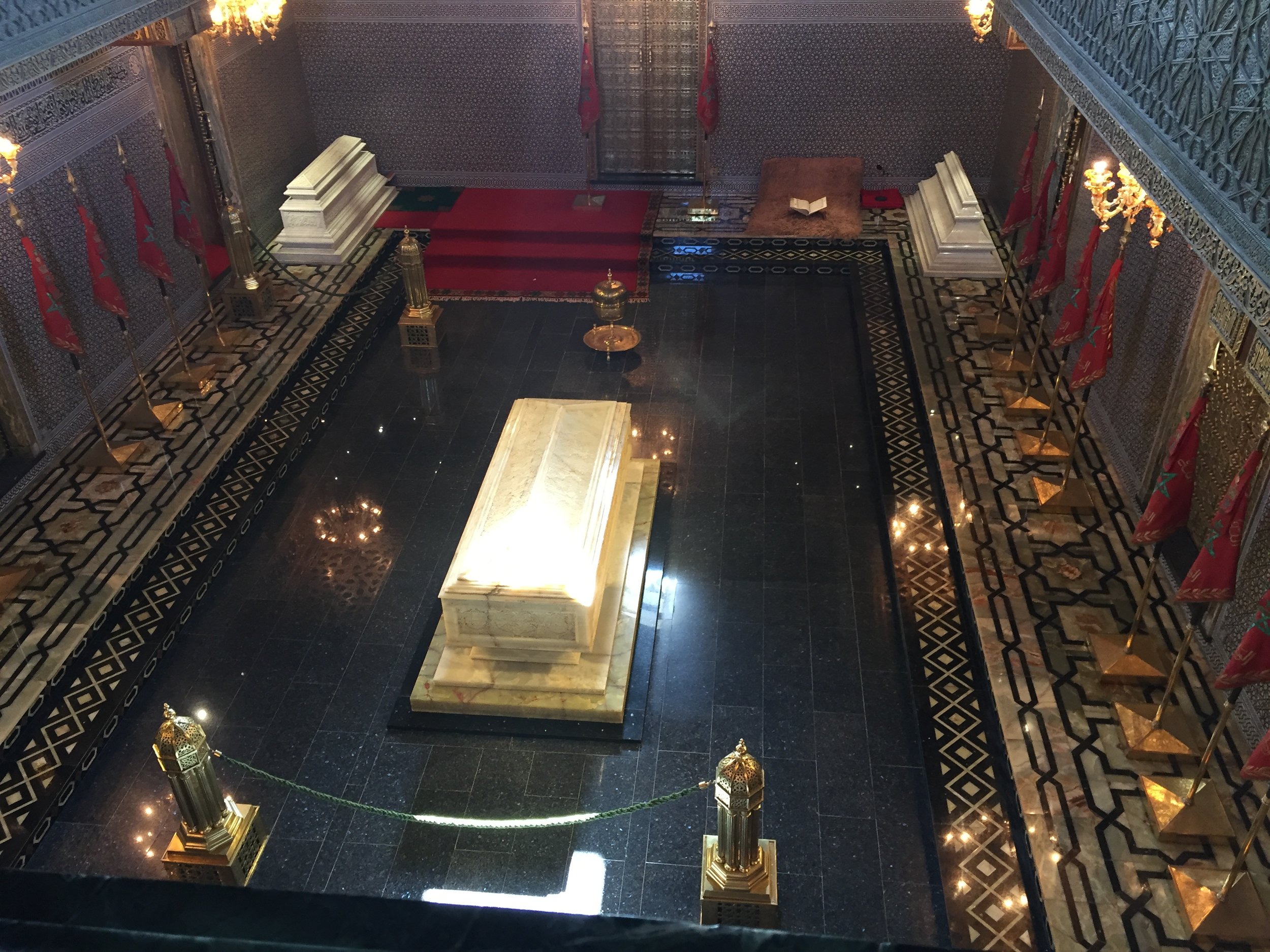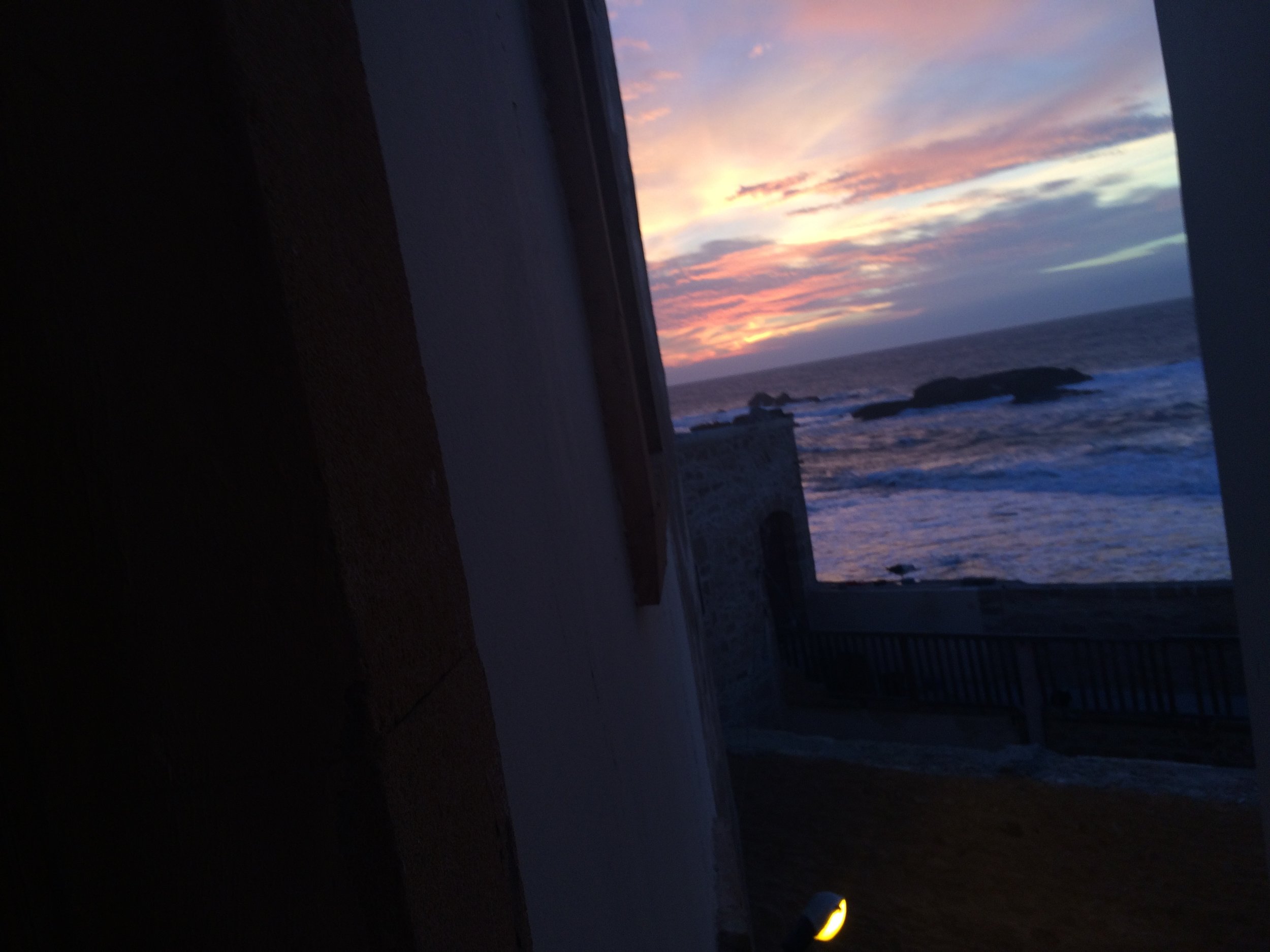Fez
Today we depart Fez for the City of Rabat, the capital city of Morocco and the seat of government, if not the seat of finance and commerce in the country. This is a short drive and when we arrive a local guide shows us the most active of the Royal Palaces, where Muhammad VI and his family routinely live and are schooled. We then visit the Chellah Ruins where the ancient Romans had their fort and trading outpost next to the river, then Hassan towers, theOudayas Gardens, and finally King Mohamed V Mausoleum, a beautiful and intricate structure designed by a French architect , it houses the crypts of 2 kings and the late King V’s brother. This late King was the father of the current King VI. Apparently, their governing styles are quite the opposite. The current King avoided the “Arab Spring” phenomenon by introducing new policies and advancing a new , more liberating constitution. Portraits of King VI adorn every shop and store. He is loved by the people and by all our guides.
Rick's Cafe
Casablanca
We arrive in Casablanca after another long bus ride. It is near dusk. We droveby the original “Rick’s Café” of movie fame with Humphrey Bogart. The movie was filmed in Hollywood, but the story was apparently based upon this american owned business. After settling in, our group walked the long waterfront and beach of this booming economic city. We are hungary and being left to our own devises find a British food chain popular with our friends called “Wok to Walk”. Great oriental stir fry. While sitting there the powers goes out for 30 minutes. Our guide tells us that on that major street they turn the power off when the KingVI is driving his own car. Great story. Is it true?
The next morning we visit the third largest Mosque in the islamic world, called the Hassan II Mosque, designed by french architect Michel Pinseau. It accommodates 25,000 worshippers inside and 80,000 worshippers in the exterior courtyard. Men and women are separated but can attend at the same time. Each gender has its own ablution fountains. The minaret is 210 meters and is the highest in the world. It is said the structure is large enough to house Rome’s St. Peter’s Cathedral. The woodcarving and elaborate decoration is most striking.
Pano view of inside the mosque
The huge mosque
We then visit the neighborhood of Anfa, where the meeting of Roosevelt, Churchill and De Gaulle took place to negotiate the future independence of Morocco from French colonialism. Then off we go toward our starting point back in Marrakech
great hotel in Essaouria
Dinner at Travos Cafe, what a great group
Essaouria
Our long drive is to the sea resort town of Essaouria, pronounced “essowherea”. This is a UNESCO world Heritage listed city. OMG! This is a small jewel like beach town with battering waves hitting the rock formations by the ancient fort and traditional Medina residences and market. Some towns just have that storybook atmosphere and this is one of them. This was originally a fishing town and the marina is still lined with working boats. There is also a long, flat, sandy beach for sun worshippers and constant winds making this locale a world class wind surfing venue with professional competitions, thus its own coined name of “windy city”. We walked the market streets of the Medina, which are wide, giving the feeling of openness. The gals favorite shop was this particular jewelry shop, with similar items priced much less than the Fez versions. Our hotel is traditional, but impeccable and for $30 Janet added a great one hour massage. Our view of the water was great, see the pics below from the roof and our room. The night of arrival we ate and drank at a place called “Travos Cafe”, one of many roof top restaurants with live music that over look the water. Great fun! We all wish we could have spent another night in this town.
Marrakech
Finally, we arrive back in Marrakech. It is said this is the city where the Arab culture of the cities meet the Berber culture of the mountain villages. Historically, it was here that the sub Saharan Traders carrying gold, salt and slaves would trade their wares to merchants who would sell them to European markets. Our group visited these sites in the Djemaael Fna Square and also walked through another shopping maze of Medina streets on our way to and from the Bahia Palace. This palace was modeled after the great Al Hombre in Spain, with interior gardens, patios, and large private rooms and baths.
The market of Marrakech
Our group and Koranic tour guide
Janet was not satisfied with stopping her ancient sites visit without a tour guide and convinced our touring friends to visit the ancient Koranic school building. She paid out $100 Dhs for this old monk kind of guy to show us around. He spoke enough english to repeat his bit about ten times as we travelled through the building. We all started to look sideways and shake our heads. Janet asked him to join our group photo. He agreed then surprised us by flipping on his hood that had been hanging down but only after removing his stored bag lunch. The guy was a hoot.
We finished our evening by finding a third floor bar above a restaurant to enjoy some spirits, reenact the tour given by the monk guy at the Koranic school, and just laugh. We got so comfortable with our 2 for 1 drinks that we just settled in for dinner and ordered what was suggested by our French hostess.
We finished our evening by again walking through the square. We did not see and snake charmers, but it was a crowd filled area of activity. I think we all felt safe. Our Guide picked us up at the designated location and we completed the tour seeing great sites and making new friends.
Final thoughts on Morocco
We debated going to Morocco considering the current world situation with Islam Nations. We are so glad that we added this wonderful country to our trip.
We took a circular route around Morocco which is exquisite with its shorelines on the Mediterranean and Atlantic oceans, the Atlas mountain range through its middle and the Sahara Desert to the east. The Moroccans are quick to point out that this is north Africa, not the Middle East. The early ancestors (2500 BC) were nomads who may have been distant cousins to the Egyptians, but considered themselves “free people”. The Romans controlled the coasts but could not conquer the tribes that they called “barbarians” which later became known as “Berbers” as they still proudly call themselves. The Berbers are the original people of Morocco with their own language, arts and deities. They lived side by side Berber Jews and a smattering of Christians. It was not until the 7th century that the Ottoman Empire extended the Islamic influence from Mecca to north Africa, but not without a fight. The Berbers led by their warrior Queen Uqba drove the Islamic armies back to Tunisia. Later by the 8th century the Islamic faith had extended to Spain, surrounding Morocco and the religion was accepted diplomatically.
The third largest mosque in the world sits in Casablanca, however many Moroccans cities still proudly maintain large Jewish populations in the neighborhoods called “Mellahs”, coined from the translation of “salt business” historically run by the Jewish community. Important to note are the social and political reforms offered by the current King Muhammed VI, whom the people seem to love. Also, he is fostering renewed economic prosperity and new infrastructure to the country which is evident in the small villages as well as the large cities we visited. For example, we were told a new Ford Motor Co. plant was being built and that a recent law prohibits the wearing of Burkas in the general public to alleviate safety concerns. What a great country with friendly people. We urge all people considering a trip here to go!
Canyons in the Middle Atlas Mountians














